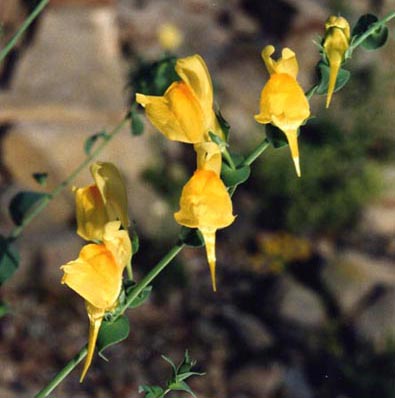
BY BLAINE BUG CREW
Welcome back readers to the first installment of Weed of the Week for the summer of 2023. We would like to highlight Dalmatian toadflax. This is a weed that is familiar to many Blaine County residents, particularly those living in southern Blaine County.
This weed does particularly well in the rocky, silty soil of this valley bottom. This is a weed that homeowners and land managers need to get on top of in the early spring because it has completely gone through its life cycle by the middle of June. Here are some interesting facts about the noxious nature of this weed:
Dalmatian toadflax is a perennial that grows up to 4 feet tall. Its waxy green leaves are heart shaped, 1 to 3 inches long, and clasp the stem. Flowers are 1 inch long (excluding the 1⁄2-inch spur), yellow, often tinged with orange or red, and similar in shape to a snapdragon.
Plants flower from midsummer to fall. Seeds are produced in a 1⁄2-inch pod and are irregularly wing angled. A single plant may produce up to 500,000 seeds in a season, which may remain viable in the soil for up to 10 years. This plant also reproduces vegetatively by stems that develop from adventitious buds on primary and sparsely vegetated areas, such as roadsides, abandoned or unmanaged land, gravel pits, and disturbed pastures and rangeland. It is found in most counties in Idaho. This invasive plant and linaria species are reportedly toxic to livestock.
Dalmatian toadflax is controlled by an insect predator. Adult Mecinus Janthiformus are small, somewhat elongated, bluish-black weevils, which emerge from last year’s infested Dalmatian toadflax stems in April-May. Adult Mecinus Janthiformus feed on toadflax stems that are at least 0.04 inches in diameter and feed on leaves and stems from June to mid-July before mating and laying eggs inside new shoots. The eggs typically hatch in 6-7 days. Larvae tunnel within the toadflax stem for 23 to 34 days, moving no more than 1.2 inches from where the egg was laid. Pupation occurs within the stem. Adult feeding on stems and leaves has a limited impact on the plant.
Larval mining impacts the plants by causing premature wilting of shoots and suppressing flower formation. Mecinus Janthiformus overwinter as adults inside their pupation chamber. The effects of the weevil on the plant are reportedly enhanced under drought stress.
Now that you know some facts about Dalmatian toadflax, it looks like you will be able to spot infestations near you and know of a solution to manage the infestation through biological control. If you have spotted an infestation, please contact Morgan Baird at (208) 788-5543 ext. 1136.
